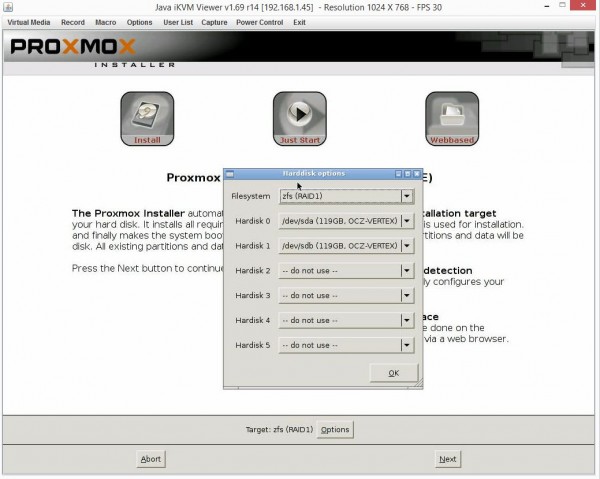Install Proxmox Software Raid 1
I've been asked to install Proxmox VE 3.0 on a new server having a Intel RSTe raid controller. Unfortunately this raid controller is not well supported under linux. Proxmox VE 2.x With Software Raid Proxmox Virtual Environment is an easy to use Open Source virtualization platform for. First we install software raid aka mdraid.
Mike Kesler During installation of Proxmox VE 3.3 (available ), you are only given the choice of what disk you want to use for the installation process, but not what disk layout you want to use. Now, there are several ways of installing Proxmox on a software RAID. One of them is to run through the standard installation process and add a software RAID afterwards, using mdadm. This blog post is just to show how setting up a software RAID on a fresh Proxmox installation worked for me! Feel free to try the following steps on a clean installation - however, I recommend not to perform these actions on a live production environment! I do not take responsibility for any data loss that might occur! Also, keep in mind that running Proxmox VE on a software RAID is neither supported nor recommended by Proxmox!
Now, that we got the disclaimer out of the way, let’s get started: Installing Proxmox Follow through the installation, using the provided ISO installer. Keep track of what disk you use as the installation disk - in my case, this would be /dev/sda. Once you complete the installation, run the following steps to get an up-to-date Proxmox VE Version to work with. Root@server:/# apt-get update root@server:/# apt-get dist-upgrade root@server:/# apt-get upgrade Next step, if you haven’t done that already, is to install mdadm root@server:/# apt-get install mdadm Setting up the software RAID mirror After finishing the installation, this is the partitioning scheme I had to work with: root@server:/# parted GNU Parted 2.3 Using /dev/sda Welcome to GNU Parted! Type 'help' to view a list of commands.

Install Proxmox From Usb
(parted) print Model: ATA HGST HUS724020AL (scsi) Disk /dev/sda: 2000GB Sector size (logical/physical): 512B/512B Partition Table: gpt Number Start End Size File system Name Flags 1 1049kB 2097kB 1049kB primary biosgrub 2 2097kB 537MB 535MB ext3 primary boot 3 537MB 2000GB 2000GB primary lvm Partitions 2 and 3 are the ones that need to be mirrored. Let’s prepare the second disk by copying the partition table from sda to sdb and changing the partition types to RAID.
Root@server:/# sgdisk -R=/dev/sdb /dev/sda root@server:/# sgdisk -t 2:fd00 /dev/sdb root@server:/# sgdisk -t 3:fd00 /dev/sdb Checking the partition table on sdb, it should now look like this: root@server:/# parted GNU Parted 2.3 Using /dev/sda Welcome to GNU Parted! Type 'help' to view a list of commands. (parted) select /dev/sdb Using /dev/sdb (parted) print Model: ATA HGST HUS724020AL (scsi) Disk /dev/sdb: 2000GB Sector size (logical/physical): 512B/512B Partition Table: gpt Number Start End Size File system Name Flags 1 1049kB 2097kB 1049kB primary biosgrub 2 2097kB 537MB 535MB primary raid 3 537MB 2000GB 2000GB primary raid We now need to create the needed RAID arrays. Because we booted from a non-RAID partition, we are going to add a missing disk into the RAID for now.
This missing disk will later be replaced by sda. Root@server:/# mdadm -create /dev/md0 -level=1 -raid-disks=2 missing /dev/sdb2 root@server:/# mdadm -create /dev/md1 -level=1 -raid-disks=2 missing /dev/sdb3 You might run into an error, saying “mdadm: cannot open /dev/sdb2: Device or resource busy”. In this case, make sure you don’t have running RAID sets already, which could happen if your disks on this machine have been used in a RAID array before. If this is the case, you want to wipe out the first 512 bytes of your disk to clear any existing RAID metadata - this was a big headache for me, took me a while to find out what the problem was. Root@server:/# cat /proc/mdstat Personalities: raid1 md1: active raid1 sdb21 523968 blocks super 1.2 2/1 U. unused devices: root@server:/# mdadm -stop /dev/md0 mdadm: stopped /dev/md0 root@server:/# mdadm -stop /dev/md1 mdadm: stopped /dev/md1 root@server:/# dd if=/dev/zero of=/dev/sda bs=512 count=1 root@server:/# dd if=/dev/zero of=/dev/sdb bs=512 count=1 We need to format md0, copy grub onto it and set it up as our /boot mountpoint. Root@server:/# mkfs.ext3 /dev/md0 root@server:/# mkdir /mnt/tmp root@server:/# mount /dev/md0 /mnt/tmp root@server:/# cp -ax /boot/.

/mnt/tmp root@server:/# umount /mnt/tmp root@server:/# rmdir /mnt/tmp Let’s not forget to edit the fstab, so it will mount /boot from md0 from now on. I commented out the previous /boot entry, just in case /dev/pve/root / ext3 errors=remount-ro 0 1 /dev/pve/data /var/lib/vz ext3 defaults 0 1 #UUID=1e2982a5-75b8-4e62-a5dc-7a49226d842f /boot ext3 defaults 0 1 /dev/md0 /boot ext3 defaults 0 1 /dev/pve/swap none swap sw 0 0 proc /proc proc defaults 0 0 Also, you need to edit /etc/default/mdadm -AUTOSTART=false +AUTOSTART=true -INITRDSTART=’none’ +INITRDSTART=’all’ Now we need to change a few grub entries and finally reinstall grub.
Deze kun je in de winkel of online aanschaffen. Het belangrijkste wat je nodig hebt is een R4 DS-kaart en een microSD-kaart. Je kunt de spellen downloaden samen met een emulator als je ze op je computer wilt spelen, maar wil je ze spelen op een DS, dan heb je wat extra uitrusting nodig.  Zorg dat je beschikt over de noodzakelijke onderdelen.
Zorg dat je beschikt over de noodzakelijke onderdelen.
Software Raid 1 Windows Xp
I’ve been asked to install Proxmox VE 3.0 on a new server having a Intel RSTe raid controller. Unfortunately this raid controller is not well supported under linux and even if properly configured, when I tried to install Proxmox VE 3.0 from the provided ISO image I could not see the RAID disk but I was seeing the two separate disks. After some search I found this good HowTo from Dominic Pratt. It is in German, I translated with google and after some issues I could reach my goal.